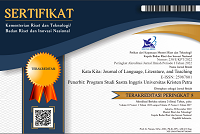Prey: Cyberbullying’s Consequences Toward Victim’s Mental Health and His Social Life
(1) Petra Christian University, Jl. Siwalankerto No.121-131, Siwalankerto, Wonocolo, Surabaya
(*) Corresponding Author
Abstract
This screenplay project focuses on cyberbullying's impacts on its victims, both mentally and physically. The goal is to shed light into this action of crime that is often overlooked, to make a better cyberspace environment, and to raise awareness to the public, especially cyberbullying perpetrators, to stop what they are doing. To do so, this creative thesis uses the cyberbullying concept that points out how cyberspace bullying can trigger paranoia and depression among many other mental disorders. The work is based on theories on paranoia, depression and cyberbullying itself. From the screenplay, it is shown how the main characters got cyberbullied, and later went from a healthy, hardworking, resilient man to a mentally broken human being as a consequence. By understanding the impact the act of cyberbullying can have on a person’s life, cyberspace users can be more responsible and refrain themselves from the act of cyberbullying.
Keywords: Cyberbully, Screenplay, Depression, Paranoia, Psychological Thriller.
Full Text:
PDFReferences
Cesar, J., & Chavoushi, F. (2013). Background Paper 6.15 Depression. Priority Medicines for Europe
and the World "A Public Health Approach to Innovation" Update on the 2004 Background Paper, 1-112.
Cromby, J., & Harper, D. (2009). Paranoia: A Social Account. Theory and Psychology, 19(3),
-353. https://doi.org/10.1177/0959354309104158
Enough. (n.d.). Cyberbullying Statistics.
Retrieved January 10, 2021, from https://enough.org/stats_cyberbullying
Fegenbush, B., & Olivier, F, D. (2009). Cyberbullying: A Literature Review.
Henry, K. (2019). The Sociopathic Behaviour in Gone Girl. Katakita, 7(2), 214-219.
https://doi.org/10.9744/katakita.7.2.214-219
Hidayah, N. (2018). Internal Conflicts Faced by The Main Characters of My Sister’s Keeper
by Jodi Picoult.
Hinduja, S., & Patchin, J.W. (2008). Cyberbullying: An Exploratory Analysis of Factors
Related to Offending and Victimization. Deviant Behaviour, 29(2), 129-156.
https://doi.org/10.1080/01639620701457816
Jakarta Post. (2019, May 16). Half of all netizens in Indonesia victims of cyberbullying: Study.
https://www.thejakartapost.com/life/2019/05/16/half-of-all-netizens-in-indonesia-victims-of-cyberbullying-study.html
Lewis, K.C., & Ridenour, J. (2017). Paranoid Personality Disorder. Encyclopedia Personality and
Individual Differences (In V. Zeigler-Hill & T. K. Shackelford ed.). Springer.
https://doi.org/10.1007/978-3-319-28099-8_615-1
Marcus, M et al. (2012). Depression: A Global Public Health Concern. World Health Organization
Paper on Depression. 6-8.
Pittard, C. (2012). Psychological Thrillers. The encyclopedia of the gothic (In W. Hughes, D. Punter, &
A. Smith Ed.). 531-533. Wiley-Blackwell.
Schenk, M. A. (2011). Psychological Impact of Cyberbully Victimization among College Students.
Graduate Theses, Dissertations, and Problem Reports
https://researchrepository.wvu.edu/etd/3293
UNICEF. (2019, September 3). UNICEF poll: More than a third of young people in 30 countries report
being a victim of online bullying.
https://www.unicef.org/press-releases/unicef-poll-more-third-young-people-30-countries-report-being-victim-online-bullying
Wirback, T. (2018). Depression Among Adolescents and Young Adults-Social and Gender Differences
Karolinska Institutet.
DOI: https://doi.org/10.9744/katakita.9.2.243-252
Refbacks
- There are currently no refbacks.
Supported by:
Indexed in:
Tools:
Stats (installed since 17 December 2018)
View My Stats













